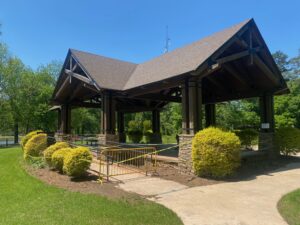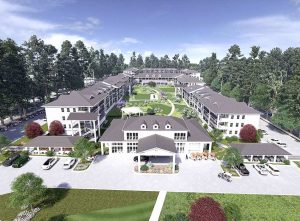With a projected shortfall of $757,128 in the upcoming 2010-2011 fiscal year — and a projected $621,674 shortfall…
in the current year’s budget — the Peachtree City Council is facing
tough decisions at its retreat at City Hall Friday and Saturday.
Mayor Don Haddix foresees a small tax increase and a draw-down of some of the city’s reserve cash but downplays significant staff layoffs or extensive use of furloughs.
City staff is projecting a 0.269 mill property tax hike for the fiscal year starting in October, equivalent to a $26.90 property tax increase for a home with a fair market value of $250,000.
Finance Director Paul Salvatore said those models calculate the city’s service levels remaining the same as they are today, though staff has been preparing figures on how furloughs might help save the city money despite how tricky they would be to implement from a service delivery standpoint.
The outlook for property owners gets worse farther in the future, as Peachtree City’s financial staff projects property tax increases to help balance the city’s budget for the next four years with no cuts in personnel or services — overall, a 38 percent jump in the city’s tax millage rate.
It’s in the following years that staff is projecting significant millage rate increases: 0.6 mill for FY 2012, 1 mill for FY 2013 and 0.250 mill for FY 2014.
The total projected tax increase over four years would be 2.119 mills. The current city millage rate is 5.533. It would top out in FY 2014 at 7.652, according to staff documents posted online at the city’s website in preparation for the retreat.
The combined effect of those rates would result in a property tax increase of $211 for a home valued at $250,000 over that four-year period, according to the city’s financial modeling.
It also could be that council decides to adopt service cuts that could shrink or eliminate a .269 mill property tax hike in October, Salvatore said.
Yearly increases in the millage rate would be 5.2 percent next year (beginning Oct. 1, 2010), 11.1 percent in FY 2012, 16.7 percent in FY 2013, and 3.6 percent in FY 2014, the city projections state.
These figures are model projections only from city staff, not recommendations, and are intended to provide a starting point in discussions among council members, Salvatore said.
They will have their first public discussions on the matter this Friday and Saturday although the first draft of a recommended budget from city staff won’t be coming forward until June.
City staff wants council input on the 2011 budget in terms of the millage rate, use of the city’s reserve fund to balance the budget if any, any changes to employee benefits and any potential salary increase. The projected budget includes no salary increases for the coming 2011 fiscal year.
Staff projects an increase in the city budget from the projected revised figure for this year of $26.541 million to a new top of $29.881 million in FY 2014.
Mayor Haddix said he couldn’t speak for the rest of council but said he would prefer to have a quarter mill tax increase and use some of the city’s reserve fund to meet a projected $757,000 shortfall in the upcoming 2010-2011 fiscal year.
Haddix said he doesn’t anticipate any “significant” staff cuts because that would equate to service cuts which would diminish the city’s appeal to companies which might be willing to move here.
“That will kill us trying to get employers here,” Haddix said, adding: “We’re understaffed now.”
“I don’t know where we possibly could reduce any significant number of people. I have no idea where they would come from without shutting down some associated services completely,” Haddix said.
Likewise, Haddix said while the use of furlough days can’t be completely dismissed the thought is “not appetizing” because it would boil down to a cut in services.
But should a two-mill increase be necessary at some point, Haddix said he would rather cut services first than enact such a tax hike. Haddix hopes to lower the city’s millage rate in the future.
Council must also address newly-anticipated shortfalls in the current year’s budget. First on the agenda is plugging the gaps in this year’s city budget and figuring out how to balance next fiscal year’s budget.
“Considering all over/under amounts for revenue projections, staff currently projects a net revenue shortfall of $621,674” for this fiscal year, according to city staff documents prepared for the retreat. That’s for a new projected FY 2010 budget of $26.5 million.
Even with the expected shortfall, city staff projects the city will end FY 2010 Sept. 30 with a 32 percent cash reserve, a percentage many local governments would envy.
The city’s reserve fund should ideally be at 20 percent of the annual uses of funds for the city, Finance Director Salvatore has said previously.
To address the shortage in this year’s budget, the “city manager has instructed all directors and chiefs to identify 2.5 percent of their divisions’ budget for possible cuts,” the city staff documents say.
Those cuts will be discussed at the end of the retreat Saturday; the discussion is tentatively set to end with a discussion from 2:15 to 2:30 p.m. on budget guidance for the current fiscal year and also the 2011 fiscal year.
The worst shortfall this year for city revenues comes from recreation program fees, which are down by $200,000 from expectations, the city documents show. The city has also taken hits in electric franchise tax ($139,000); interest earnings ($148,513); city court fines ($128,500) and building permits ($113,052).
Haddix said the city can use remaining revenues from the 2004 transportation SPLOST to help with budget shortfalls, but a new SPLOST will be needed in the future to avoid property tax increases, he said. The city used between $1.8 and $2 million a year to pay for road and cart path repair and improvements and without that SPLOST such work will come from the general fund, Haddix said.
The city’s review of the remaining SPLOST dollars shows that with the $19 million east Fayetteville bypass cancelled, there will be enough to do all of the city’s SPLOST projects as well as those in all other jurisdictions in the county, Haddix said.
Haddix said the city needs to increase its funding for the city’s development authority, currently budgeted at $35,000 a year. The authority, which has been working largely on redevelopment and business-related issues involving the village centers, needs a full-time staffer to advance the authority’s goals, Haddix said.
While the county has a separate development authority to pursue corporations and businesses, the city is responsible for filling its commercial and office spaces, Haddix said.
Other areas to be discussed at the retreat:
• The most recent monthly average home sales price in Peachtree City was $327,625 for single-family homes and $210,000 for townhomes and condominiums, according to a city study.
The average monthly price has yo-yo’ed over the past 18 months, the study shows, with the low point of $250,000 having been reached in December 2008 and January 2009.
• On the retail side of the equation, Peachtree City’s vacancy rate so far in 2010 is 11 percent of available retail space, down from 13 percent for 2009 and up from a rate of 7 percent in 2008, the city study shows.
Out of 1.91 million square feet of available retail space inside Peachtree City, 218,054 square feet are vacant, the study shows.
The two oldest village shopping centers are suffering the most from the economic downturn, the study shows. Hardest hit is Glenloch Village with a 48 percent vacancy rate. Next is Aberdeen Village with a vacancy rate of 22 percent.
• In the city’s industrial park, nearly 47 percent of the available space is empty, according to the city study. The city has more than 1.4 million square feet of industrial buildings, with 678,281 square feet empty.
The bulk of that empty space is represented by the two tracts formerly occupied by the now defunct PhotoCircuits company, once one of the county’s largest private employers. The empty PhotoCircuits buildings are 318,000 square feet of the total, the city study shows.
The city still has 473.23 acres of empty industrially zoned land available, same as last year, the study shows.
• The city staff is urging the City Council to “revisit what defines village center and neighborhood center and incorporate ‘new vision’ into [Peachtree City’s] comprehensive plan.”
In a document called “Re-imaging the Village,” Interim Community development Director David Rast suggests doing away with the distinctive village signs and re-branding each village with more contemporary logos.
[Source documents for this story are on the city’s website.]
— Additional reporting by John Munford











Leave a Comment
You must be logged in to post a comment.